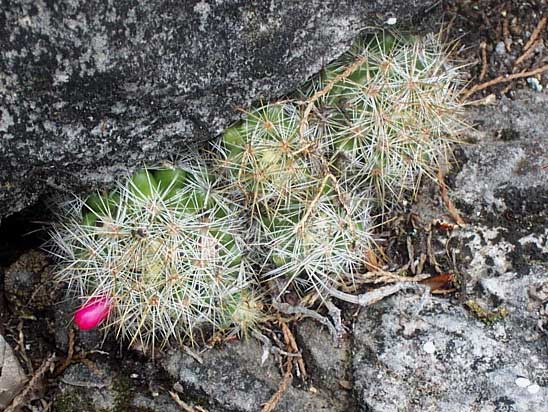Excerpts from Jim Conrad's
Naturalist Newsletter
page February 23, 2007 Newsletter issued from Sierra Gorda Biosphere Reserve Headquarters in Jalpan, Querétro,MÉXICO
NIPPLE CACTUS

The other day I had a good hike over at Cocos, the little mountain town serving as a jumping-off point for visitors to Sótano del Barro, at 1312-ft-deep (400 m) one of the world's most impressive sinkholes (N21.3109°, W99.6630°, elevation ~1800m or ~5900ft). People at Cocos are looking for ecotour attractions to keep visitors in town after they've seen the sinkhole, and the Reserve is trying to help them.
Above you can see a cactus species found there beautifully adapted to the special dry limestone environment above Cocos is the nipple cactus shown tightly wedged into a limestone crack.
That's probably MAMMILLARIA PROLIFERA*, in English usually designated the Texas Nipple Cactus. However the species' distribution area covers much more of Mexico than Texas so the name seems a bit unjust. In the picture the pinkish, oblong item protruding from the lower cactus body is a fruit.
That genus Mammillaria is a big one, with about 170 species currently recognized. The genus is fairly easy to identify in the field because Mammillaria bodies appear to be composed of numerous rounded, green "nipples," or mammary glands. Of course the Mexicans, instead of seeing green breasts, make out lots of round-topped chili peppers stacked side-by-side. Technically the green bumps are referred to as tubercles. One pleasant feature of Mammillarias is that, though they're obviously very spiny, they lack the tiny glochids that almost invisibly stick into fingers thaat probe into some other kinds of cactus.
There's a whole website just on Mammillarias at http://mammillarias.net/.